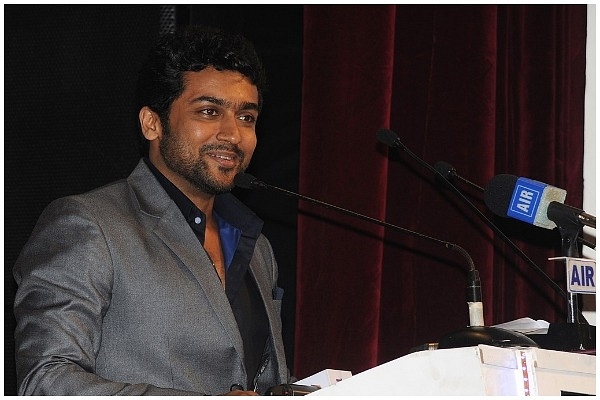
No, Mr Suriya, Draft NEP Doesn’t Advocate Closing Down Small Government Schools; Stop Your Fear-Mongering
Tamil actor Suriya recently vented his ire on the draft National Education Policy.
His criticisms seem like a typical hyperbolic Tamil movie, devoid of real-life research and respect for facts.
Popular Tamil actor Suriya recently criticised the draft National Education Policy (NEP) saying that it focused ‘much on entrance exams but not on quality and equal education to all the students.’ He was speaking at the 40th anniversary function of his family-run Sri Sivakumar Foundation, an educational trust which gives cash awards to board exam toppers from government schools.
From what the English media reported, Suriya talked about three aspects of the NEP: impracticality of implementing the three-language policy, the draft’s alleged focus on examination rather than quality and its recommendation of school consolidation.
First, there is nothing radically new in the draft NEP’s three-language formula policy. It’s been in place since 1968. The draft only talks about continuation in this regard. In fact, if anything, it recommends that Hindi speaking states introduce a language from another part of India as the third language, apart from English and Hindi. Moreover, Tamil Nadu is already exempted from the ‘burden’ of implementing the three-language formula.
Second, Suriya’s concern about the draft NEP focusing on examination rather than quality is nothing but mere rhetoric. A very small portion of the draft is dedicated to the examination system (that too on how to improve it) while the main thrust is on improving quality and equitable education. In fact, it dedicates a whole chapter to “equitable and inclusive education’. One can disagree with some of the suggestions and suggest better alternatives (as I have done), but to state that the main concern is examinations and not improving education quality or giving equitable education is patently false.
Third, Suriya said that the draft NEP was advocating the closing down of thousands of schools.
“According to the draft policy, 1,848 of such schools are set to be closed. The primary education of tribals and poor rural students would be affected, they don’t have any basic access to travel and study in some other schools. How will they perceive their primary education? What does the future hold for them?“ The Indian Express quoted the actor as saying.
I searched for this “1,848” number given by him in the draft document and believe me, I have never gotten the “no results found’ response on a PDF so fast. One is not sure where he got this number from.
The draft document does talk about the problem of a small number of schools. Quoting DISE data from 2016-17, it states that “nearly 28 per cent of India’s public primary schools and 14.8 per cent of India’s upper primary schools have less than 30 students. The average number of students per grade in the elementary schooling system (primary and upper primary, i.e. Grades 1-8) is about 14, with a notable proportion even below 6; during the year 2016–17, there were 119,303 single-teacher schools, the majority of them (94,028) being primary schools serving Grades 1–5.”
Plus, ‘80 per cent of our elementary schools have three or fewer teachers.’
So, India really has a problem of increasing number of small schools. Hence, school consolidation isn’t as much a question of choice as it is of necessity.
According to Professor Geeta Kingdon, in 41 per cent of the public schools, which had an enrollment of less than 50 students each (around four lakh schools), the government spent more than Rs 50,000 per student on teacher salaries alone. Other expenditure (like on infrastructure, mid-day meals) is extra. That’s an obscene waste of public money in a poor country like India. It must be put to better use.
The NEP rightly states that small schools are economically sub-optimal and operationally complex and that they present a systemic challenge for governance and management. Additionally, schools with a small number of students and few teachers are educationally sub-optimal. As the NEP notes, “Optimal learning environments require a certain cohort size (about 15 at least) of same-age students. Teachers function effectively and optimally in teams.”
Is it any wonder then that we are witnessing an exodus of students from government schools to private ones. Between 2010 to 2017, enrollment in government schools declined by 2.5 crore students, while it increased by 2.1 crore students in recognised private schools. Others may have joined unrecognised ones or dropped out.
In this light, school consolidation is being discussed. But, one doubts if Suriya has read the draft NEP at all. Because, it explicitly says that and I quote, “Consolidation must be done very judiciously, and only when it is ensured that there is genuinely no impact on access. This is likely to result in only a small degree of consolidation, something that will not solve the structural problem.’
That’s why the draft NEP has not even focussed on consolidation at all as its main policy suggestion. Instead, it has recommended a new concept: School Complexes where small schools will be integrated administratively (not physically, mind you).
The NEP explains that ‘each school complex will be a semi-autonomous unit that will offer education from the Foundational stage (age 3-8 years) till Grade 12 (age 18). The complex will consist of one secondary school (covering Grades 9-12) and all the public schools in its neighbourhood that offer education from pre-primary till Grade 8.....If for any reason a school complex does not have a secondary school where Grades 9-12 are being taught, then these grades must be introduced in one of the schools.”
This will end the isolation of small schools and help share resources between them. That’s the focus of the draft and not mindless closing down of schools thereby reducing access.
So, actor Suriya’s tall claim of thousands of schools shutting down and students suffering in rural areas is nothing but fear-mongering.